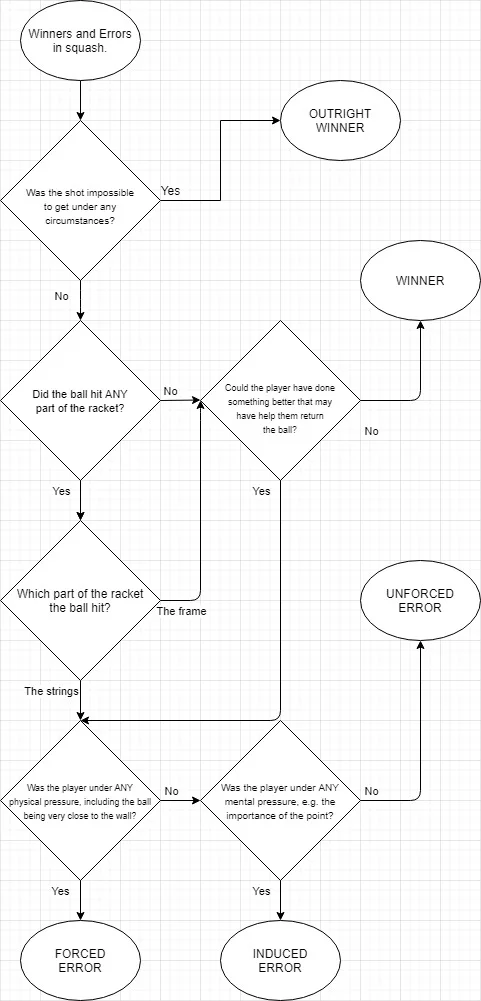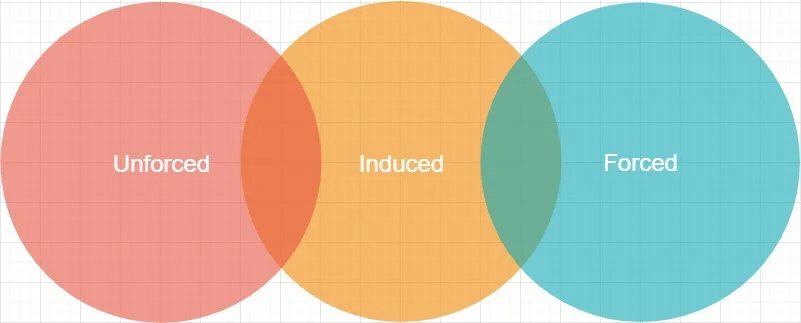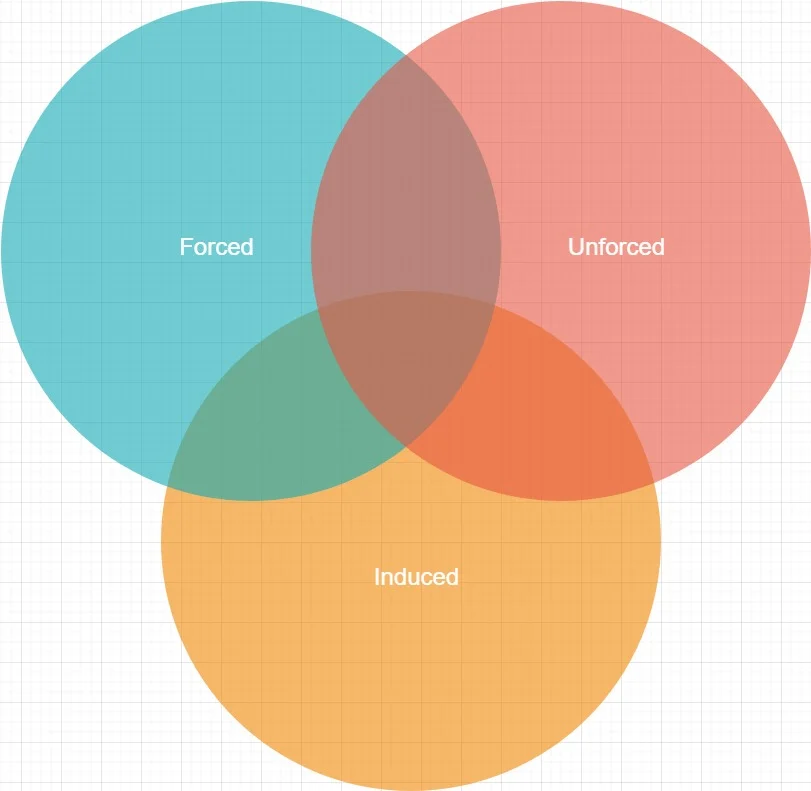Last Updated 20 June 2024 / 8-Min Read / Translate
TL;DR
About six years ago, I wrote an article entitled “The Myth of the Unforced Error” where I argued many errors traditionally called “unforced” were actually forced. In this article, I am going to further develop that argument, but also offer two new terms to allow a more nuanced view of errors.
Let’s start with the basic proposition. Having a binary definition for errors i.e. “Forced” and “Unforced” does not fully cover real match situations or circumstances. It doesn’t take into account many factors that I believe should be considered before we try to define the error.
We all think the definition of an unforced is clear; “when the player could have hit the ball in” or even “you’ll know it when you see it”, but we only need to watch a few squash matches, especially professionals, to find ourselves in a quandary regarding some of those errors.
I will be arguing that there are in fact three possible types of errors.
In addition, I will also be advancing the theory that errors can be made because you are mentally under pressure. These are currently grouped into “unforced”, partly because there was no obvious physical reason to miss and partly because, as is my contention, the mental aspect is ignored.
To make things easier to visualise I am going to call the players A and B. Player A hits a shot and player B is trying to retrieve it. Player B is the one who “makes the error”. The actual court positions and type of shots are not important at this stage, except to say that player B has always moved significantly to reach the ball and the ball never rolls in the nick. I say this because ANYTHING else is essentially “getable”, “reachable”, “playable” or whatever word or phrase you want to use. Let’s look at a few possible scenarios.
Scenario 1 – Miss: Player A hits a shot and player B attempts to return it, but the shot is too “good” and player B misses the ball completely. Because player B didn’t make contact with the ball we class this as a “winner”. This is never called an unforced error because B couldn’t even get there, so no error, right? An exception to this description could be a straight drive that is touching the sidewall. We would also certainly call this a “forced” error. Has player B made any errors? Well, without opening up a HUGE can of worms – No. Perhaps player B could have moved sooner, or positioned themselves better, but we would never really know.
Scenario 2 – Frame: Player A hits a shot and player B attempts to return it, and gets close enough to make contact with the frame. If the ball is in open court, we would probably call that a “winner” for player A. Player B couldn’t even get the strings to the ball, so it wasn’t their fault or error, was it? But what if that player had moved just a tenth of a second sooner or hadn’t misjudged the angle? Did player A really hit a winner? Was there nothing player B could have done to make better contact with the ball? If player B had, would he or she have been able to hit a proper shot? If so, were they really forced to move late?
Scenario 3 – Strings: Player A hits a shot and player B attempts to return it, and manages to make contact with the strings, but the ball goes out or hits the tin. Currently, in most cases this is defined as an “unforced” error. With the thinking being that if player B can get a clean hit then they could have hit it in. That doesn’t sound too unreasonable, does it?
At this point I am arguing that knowing whether player B really was physically “forced” into making a mistake is not as simple as whether he or she made contact with the strings or not, nor whether the ball was touching the wall.
Also, the definition of a “winner” might be help. Traditionally, it was a shot that wasn’t touch by the opponent’s racket, as in an ace in tennis. But I call those “outright winners” and use the term “winner” to mean a shot that a player hit that won the point due to its quality – irrespective of whether the losing player touch it with their racket or not. But I acknowledge that my definition is not universally accepted or even liked!
It’s time to introduce the mental aspect of errors.
At the recent Australian Tennis Open 2021, Serena Williams was playing Aryna Sabalenka. The score was 1 set each. Sabalenka was serving at 0-15 and 4-5 in the final set. After a good serve, Sabalenka seemed in control of the rally. Williams was scurrying all around the court and getting shots you really didn’t think she could. On the thirteenth shot of the rally, with Williams having hit a high return, Sabalenka was standing just in front of the baseline, well balanced and about to smash. Williams was about 3 or 4 metres behind the baseline. Sabalenka smashed the ball into the top of the net and lost the point. Clear “unforced” for some.
However, I truly believe she was “induced” to make this error by some tremendous defensive play by Williams and the importance of the score. Sabalenka had already hit at least 2 shots that could have been winners. Anything less than a great shot was going to be returned and possibly “with interest”. And let’s not forget the score. Sabalenka was serving to stay in the tournament. If the exact same rally had occurred at 2 games all in the first set, do we really believe that she would have hit the top of the net? I don’t. And if she had, I would have probably called that an “unforced” error too. At whatever level you consider, there are margins of errors. A ball can be 4cms or 8cms above the tin and still be a winner, but not at higher levels or standards. The better you get, the finer the margins of error.
Not only does the example show how good shots have to be to be “winners” at professional level, but it also shows how important mental pressure can be. Both the score AND the fact that Williams returned shots that she was not expected to, played a part in the mental pressure Sabalenka must have felt.
Am I saying that there are no unforced errors in professional squash? No, of course not, but I am saying and have been saying for years that a binary definition is not useful. As a coach, I want my players to better understand what happens on a court and having the current “forced” and “unforced” doesn’t do that. We need to accept not just the physical component of an error, but also the mental one too.
Please don’t think that this only happens at professional level because it doesn’t. Imagine playing somebody at your club or facility that is a few “levels” above you in grade or ladder. Playing your usual game clearly won’t work. The opponent is a better all-round player, or better at enough things that they would easily beat you.
So what do you do? You aim lower of the tin, you try for winners when you normally wouldn’t, you HAVE to try something because otherwise, you will eventually lose. Traditionally, the errors you make in those circumstances would be called “unforced”, but really they are induced – induced due to the circumstances.
In fact, I have a personal anecdote for this. I was playing in the qualifying rounds of the World Open in 1998 and was drawn against a professional, whose name I can’t remember, and it was clear I was going to lose. He was much, much better than me. I decided the best thing to do was “just go for it” and lo and behold I found myself 6-0 in the first game (up to 9 BTW) and suddenly I thought “Oooo, maybe I *can* win this!” and I started to play more conservatively. The next thing I know I am 7-8 down and its game ball. I lost that game. As I got more tired, I went for shots that were just not on and I lost the next two games pretty easily. Just to be clear, I don’t think I would have won the match if I had continue to go for it, but I knew it was my only chance and I made a LOT more mistakes than I would normally make.
And the reverse is true for your opponent. Errors against players of a lower standard could be called unforced, whereas almost the exact same error against somebody of their same standard might be induced.
We see this more later in what I call “Error Level Fluidity”.
(As a side note, I always used to tell me pupils that if they were playing a much higher ranked player, better to keep them on court for an hour and lose 3-0 than go for every single shot and maybe lose 3-1 or 3-2. Getting lucky, doesn’t get you better!)
It is at this point, I want to introduce a new term and definition: The Induced Error. This is an error that a player has been induced to make from some physical, mental or both types of pressure. Some form of contact with the ball and racket must be made for it to be induced. The induction could be because of tremendous retrieving, because of the importance of the point or score, or even something other reasons I can’t describe at this time. My point is there was some outside influence.
I don’t believe objective sentence-length definitions are easy. People will always argue about the boundaries between types of errors and having three types instead of two means there are two boundaries to argue about instead of just one.


Visualizing things in different ways could help. Which Venn diagram below do you think best fits reality?
Diagram 1: Two Set – A linear relationship, with clear overlap between two types errors.

Diagram 2: Three Set – Perhaps closer to how viewers may see real world errors.

One circumstance that needs more discussion are shots that are touching the sidewall. Unless a player is rushing to get the ball, for me this is an induced error not a forced error, especially at high levels of squash. Players return shots touching the wall all the time, so it’s not just the position of the ball. That said, I think each case must be considered on an individual basis.
In some ways, my three types of errors lend themselves perfectly to being redefined based on the level of the players. For example, at club level a player missing a ball because it is touching the sidewall is closer to a forced error, whereas at professional level that is more of an induced error. This ability to be redefined the type of error based on the circumstances and standards of the players may help players better adapt their tactics and playing style to suit their needs, as well as allowing observers more latitude with application of error types.
Remember that “can of worms” I mentioned earlier? Well, it’s this: Should we be calling shots that are so weak as to allow the opponent to win the point an error? Admittedly, the opponent “won” the point rather than the player “losing” it by hitting it out or in the tin for example. If “something” occurs that causes the point to be won or lost, is this enough to be called an error?
How about we think of it like this. In Association Football, statistics now include “assists”, which if you didn’t know is when one player “causes” or “helps” the goal to be scored by another player. It’s in recognition that almost certainly the goal wouldn’t have been scored without the assist. We could start including “Negative Assist” as a form of analysis and statistic. Basically, Player B played a shot so weak or easy that player A was able to hit an easy winner.
Which brings us back to the ball touching the sidewall! What if player A hits a beautifully tight shot that is kissing the sidewall and player B manages to return it, but leaves it in the middle of the court for player A to hit a winner. What do we call that?
I would now like to introduce something that happened to Daryl Selby and before I do I want to be clear that I am in NO WAY making fun of him. He hit a shot and his opponent dived to retrieve it and then Daryl played a weak return; he hit a fairly easy length fully expecting his opponent to not even try to return it. However, his opponent had other ideas and raced to the ball and performed another spectacular dive and hit a winner. Daryl, understandably, stood in shock as he lost the point.
How do we even begin to define this? An unforced error, a negative assist?
Perhaps I am over-thinking this and all we need to do is accept that mental pressure can play a role in players hitting errors. If that’s the case, then we just need to apply that thinking when deciding between forced and unforced errors. If, however, we feel that the mental aspect is not quite enough to call them forced, then “induced” might have a place in future analysis.
I'd like to thank Jamie and Michael from CrossCourtAnalytics.com and Eric and Michael from SquashStats.com for talking through the ideas presented here. Both are great websites, so go check them out.